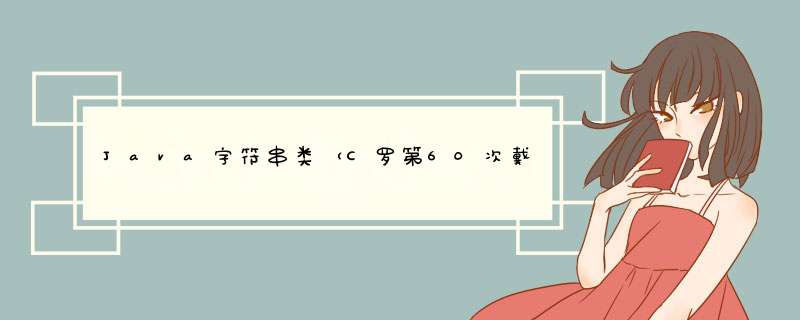
- 一 字符串的常用方法
- 1 字符串构造
- 2 字符串比较
- 1 == 比较
- 2 boolean equals(Object anObject) 方法
- 3 int compareTo(String s) 方法
- 4 int compareToIgnoreCase(String str) 方法
- 3 字符串查找
- 4 字符串转化
- 1 数值和字符串转化
- 2 大小写转换
- 3 字符串转数组
- 4 格式化
- 5 字符串替换
- 6 字符串拆分
- 7 字符串截取
- 8 除空格方法
- 二 StringBuilder和StringBuffer
String类提供的构造方式非常多,常用的就以下三种:
public static void main(String[] args) {
// 使用常量串构造
String s1 = "hello bit";
System.out.println(s1);
// 直接newString对象
String s2 = new String("hello bit");
System.out.println(s1);
// 使用字符数组进行构造
char[] array = {'h','e','l','l','o','b','i','t'};
String s3 = new String(array);
System.out.println(s1);
}
注意:
1. String是引用类型,内部并不存储字符串本身
public static void main(String[] args) {
// s1和s2引用的是不同对象 s1和s3引用的是同一对象
String s1 = new String("hello");
String s2 = new String("world");
String s3 = s1;
System.out.println(s1.length()); // 获取字符串长度---输出5
System.out.println(s1.isEmpty()); // // 如果字符串长度为0,返回true,否则返回false
}
2. 在Java中""引起来的也是String类型对象
public static void main(String[] args) {
// 打印"hello"字符串(String对象)的长度
System.out.println("hello".length());
}
对于内置类型,== 比较的是变量中的值;对于引用类型 == 比较的是引用中的地址。
public static void main(String[] args) {
int a = 10;
int b = 20;
int c = 10;
// 对于基本类型变量,==比较两个变量中存储的值是否相同
System.out.println(a == b); // false
System.out.println(a == c); // true
// 对于引用类型变量,==比较两个引用变量引用的是否为同一个对象
String s1 = new String("hello");
String s2 = new String("hello");
String s3 = new String("world");
String s4 = s1;
System.out.println(s1 == s2); // false
System.out.println(s2 == s3); // false
System.out.println(s1 == s4); // true
}
boolean equals(Object anObject) 方法:按照字典序比较
字典序:字符大小的顺序
String类重写了父类Object中equals方法,Object中equals默认按照==比较,String重写equals方法后,按照如下规则进行比较:
public boolean equals(Object anObject) {
// 1. 先检测this 和 anObject 是否为同一个对象比较,如果是返回true
if (this == anObject) {
return true;
}
// 2. 检测anObject是否为String类型的对象,如果是继续比较,否则返回false
if (anObject instanceof String) {
// 将anObject向下转型为String类型对象
String anotherString = (String) anObject;
int n = value.length;
// 3. this和anObject两个字符串的长度是否相同,是继续比较,否则返回false
if (n == anotherString.value.length) {
char v1[] = value;
char v2[] = anotherString.value;
int i = 0;
// 4. 按照字典序,从前往后逐个字符进行比较
while (n-- != 0) {
if (v1[i] != v2[i])
return false;
i++;
}
return true;
}
}
return false;
}
public static void main(String[] args) {
String s1 = new String("hello");
String s2 = new String("hello");
String s3 = new String("Hello");
System.out.println(s1.equals(s2)); // true
System.out.println(s1.equals(s3)); // false
// equals比较:String对象中的逐个字符
// 虽然s1与s2引用的不是同一个对象,但是两个对象中放置的内容相同,因此输出true
// s1与s3引用的不是同一个对象,而且两个对象中内容也不同,因此输出false
}
int compareTo(String s) 方法: 按照字典序
与equals不同的是,equals返回的是boolean类型,而compareTo返回的是int类型
1. 先按照字典次序大小比较,如果出现不等的字符,直接返回这两个字符的大小差值
2. 如果前k个字符相等(k为两个字符长度最小值),返回值两个字符串长度差值
public static void main(String[] args) {
String s1 = new String("abc");
String s2 = new String("ac");
String s3 = new String("abc");
String s4 = new String("abcdef");
System.out.println(s1.compareTo(s2)); // 不同输出字符差值-1
System.out.println(s1.compareTo(s3)); // 相同输出 0
System.out.println(s1.compareTo(s4)); // 前k个字符完全相同,输出长度差值 -3
}
int compareToIgnoreCase(String str) 方法:与compareTo方式相同,但是忽略大小写比较
public static void main(String[] args) {
String s1 = new String("abc");
String s2 = new String("ac");
String s3 = new String("ABc");
String s4 = new String("abcdef");
System.out.println(s1.compareToIgnoreCase(s2)); // 不同输出字符差值-1
System.out.println(s1.compareToIgnoreCase(s3)); // 相同输出 0
System.out.println(s1.compareToIgnoreCase(s4)); // 前k个字符完全相同,输出长度差值 -3
//忽略字符大小写
}
`
public static void main(String[] args) {
String s = "aaabbbcccaaabbbccc";
System.out.println(s.charAt(3)); // 'b'
System.out.println(s.indexOf('c')); // 6
System.out.println(s.indexOf('c', 10)); // 15
System.out.println(s.indexOf("bbb")); // 3
System.out.println(s.indexOf("bbb", 10)); // 12
System.out.println(s.lastIndexOf('c')); // 17
System.out.println(s.lastIndexOf('c', 10)); // 8
System.out.println(s.lastIndexOf("bbb")); // 12
System.out.println(s.lastIndexOf("bbb", 10)); // 3
}
public static void main(String[] args) {
// 数字转字符串
String s1 = String.valueOf(1234);
String s2 = String.valueOf(12.34);
String s3 = String.valueOf(true);
System.out.println(s1);
System.out.println(s2);
System.out.println(s3);
System.out.println("=================================");
// 字符串转数字
int data1 = Integer.parseInt("1234");
double data2 = Double.parseDouble("12.34");
System.out.println(data1);
System.out.println(data2);
}
public static void main(String[] args) {
String s1 = "hello";
String s2 = "HELLO";
// 小写转大写
System.out.println(s1.toUpperCase());
// 大写转小写
System.out.println(s2.toLowerCase());
}
当字符串中有其他字符时无视其他字符
3 字符串转数组 public static void main(String[] args) {
String s = "hello";
// 字符串转数组
char[] ch = s.toCharArray();
for (int i = 0; i < ch.length; i++) {
System.out.print(ch[i]+" ");
}
System.out.println();
// 数组转字符串
String s2 = new String(ch);
System.out.println(s2);
}
public static void main(String[] args) {
String s = String.format("%d-%d-%d",2022,4,18);
System.out.println(s);
}
使用一个指定的新的字符串替换掉已有的字符串数据
public static void main(String[] args) {
String str = "helloworld" ;
System.out.println(str.replaceAll("l", "_"));
System.out.println(str.replaceFirst("l", "_"));
}
由于字符串是不可变对象, 替换不修改当前字符串, 而是产生一个新的字符串
可以将一个完整的字符串按照指定的分隔符划分为若干个子字符串
public static void main(String[] args) {
String str = "hello hao hello kun" ;
String[] result = str.split(" ") ; // 按照空格拆分
for(String s: result) {
System.out.println(s);
}
}
public static void main(String[] args) {
String str = "hello hao hello kun" ;
String[] result = str.split(" ",2) ; // 按照空格拆分,拆成两部分,从左至右
for(String s: result) {
System.out.println(s);
}
}
有些特殊字符作为分割符可能无法正确切分, 需要加上转义
public static void main(String[] args) {
String str = "192.168.1.1";
String[] result = str.split("\.");
for (String s : result) {
System.out.println(s);
}
}
注意事项:
- 字符"|","*","+"都得加上转义字符,前面加上 “\” .
- 而如果是 “” ,那么就得写成 “\” .
- 如果一个字符串中有多个分隔符,可以用"|"作为连字符.
多次拆分:
public static void main(String[] args) {
String str = "name=haokun&age=18";
String[] result = str.split("&");
for (int i = 0; i < result.length; i++) {
String[] temp = result[i].split("=");
System.out.println(temp[0] + " = " + temp[1]);
}
}
public static void main(String[] args) {
String str = "helloworld" ;
System.out.println(str.substring(5));//从下标5开始截取到最后
System.out.println(str.substring(0, 5));//从下标0开始截取到下标5(左开右闭)
}
注意事项:
- 索引从0开始
- 注意前闭后开区间的写法, substring(0, 5) 表示包含 0 号下标的字符, 不包含 5 号下标
public static void main(String[] args) {
String str = " hello world " ;
System.out.println("["+str+"]");
System.out.println("["+str.trim()+"]");
}
trim 会去掉字符串开头和结尾的空白字符(空格, 换行, 制表符等)
由于String的不可更改特性,为了方便字符串的修改,Java中又提供StringBuilder和StringBuffer类
从上述例子可以看出:String和StringBuilder最大的区别在于String的内容无法修改,而StringBuilder的内容可以修改。频繁修改字符串的情况考虑使用StringBuilder
注意:String和StringBuilder类不能直接转换。如果要想互相转换,可以采用如下原则:
- String变为StringBuilder: 利用StringBuilder的构造方法或append()方法
- StringBuilder变为String: 调用toString()方法
欢迎分享,转载请注明来源:内存溢出

 微信扫一扫
微信扫一扫
 支付宝扫一扫
支付宝扫一扫
评论列表(0条)